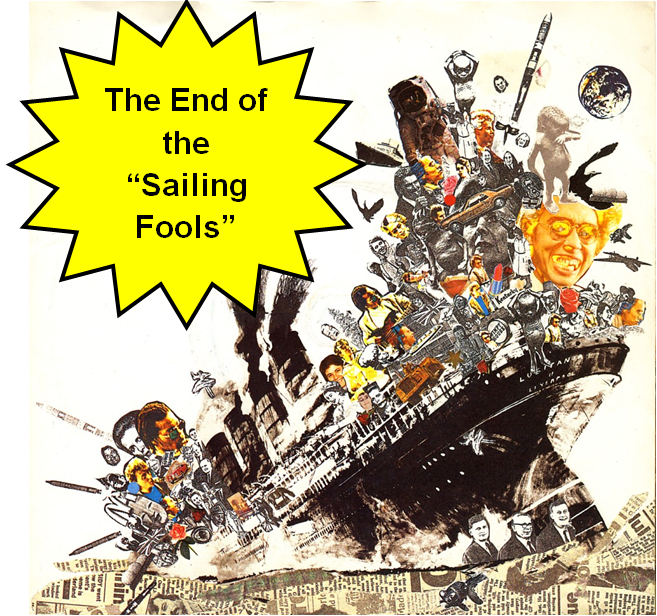There is an old saying among mariners that goes something like this: “Smart guys invented ships, so that fools can sail the seas.” Don`t get me wrong, mariners of today are multi skilled, technically sound professionals in various fields of marine business, so if there ever were a times of fools, this certainly aren’t the ones.
 These are the times of cost cutting frenzies that result in official prizes and recognition for the captains that managed to drive the daily food expenses for their crews well below $5. Let me repeat, well below $5 per day! Also these are the times in which total crew cost onboard large container ships (10 000 +) account to nearly 44% of overall operational expenses. Apparently in the case of Emma Maersk that amounts to roughly 1.3 million dollars per annum. These are also the times in which approximately 50% of maritime accidents are initiated by human error, while another 30% of maritime accidents occur due to failures of humans to avoid an accident.[1]
These are the times of cost cutting frenzies that result in official prizes and recognition for the captains that managed to drive the daily food expenses for their crews well below $5. Let me repeat, well below $5 per day! Also these are the times in which total crew cost onboard large container ships (10 000 +) account to nearly 44% of overall operational expenses. Apparently in the case of Emma Maersk that amounts to roughly 1.3 million dollars per annum. These are also the times in which approximately 50% of maritime accidents are initiated by human error, while another 30% of maritime accidents occur due to failures of humans to avoid an accident.[1]
On the other hand, as we very well know and as Mr. Asimov stated so nicely: “The only constant is change, continuing change, inevitable change, that is the dominant factor in the society today. No sensible decision can be made any longer without taking into account the world as it is, but the world as it will be.”[2]
So here we are, stage is set, it`s time to ask the question! Are the times of “sailing fools” coming to an end? Are we done sending our most valuable assets (our mariners for those who don’t see it clearly) on 30 days “torture” sails across the ocean? Is global maritime world ready to enter even vaguely serious discussion of the idea of unmanned vessels?
Rolls-Royce thinks they are, so they started developing their design last year. Apparently they figured out that by cutting out the crew they can make ships 5% lighter, consume 12.5% less fuel, and decrease other operating expenses down 44%. Bottom line amounts to roughly 50% reduction in the $375 billion industry. Ok, truth to be said, calculations show complete disregard to the fairly obvious need for additional levels of redundancy and backups which might significantly impact the scale, but lets leave it at this for the moment. EU Commission took the bate and rounded up several partners around the $4.8 million heavy project called MUNIN. Ages ago, raven Munin flew around the world independently every day to gather information for its master the Norse god Odin, now he is called to service by masters of our modern Asgard.
backups which might significantly impact the scale, but lets leave it at this for the moment. EU Commission took the bate and rounded up several partners around the $4.8 million heavy project called MUNIN. Ages ago, raven Munin flew around the world independently every day to gather information for its master the Norse god Odin, now he is called to service by masters of our modern Asgard.
Administrative hurdles set by regulators and insurers are also to be seen, although still quite shy and unoptimistic of the changes that new horizon might bring. Statements like this one: “It cannot and will never replace the eyes, ears and thought processes of professional seafarers…“ are countered by pictures like that one below.
Nevertheless, issue of roughly 1.2 million seafarers is quite a serious one. Like it or not, sailors salary has been the token of social peace for centuries now, and in most of what we tend to call “developing world” it still is. Today’s global seafarer supply by broad geographical area holds the answer to the question of why is it that EU and US are the only ones sharing the sympathy for the unmanned vessel concepts.
The OECD countries (North America, Western Europe, Japan etc.) remain an important source for officers, but growing numbers of officers are now recruited from the Far East and Eastern Europe. The majority of the shipping industry’s ratings are recruited from developing countries, especially the Far East and South East Asia.
The Philippines and India are very significant maritime labour supply nations, with many seafarers from these countries enjoying employment opportunities on foreign flag ships operated by international shipping companies. China has also seen a large increase in the number of seafarers, but at the moment most of these work on the Chinese fleet, meeting domestic requirements.
Churchill said: “Now this is not the end. It is not even the beginning of the end. But it is, perhaps, the end of the beginning.” In our particular case this might merely be the beginning of the beginning, or maybe even beginning of the end for the “sailing fools”. Jury is still out, and as so often in life, “IT DEPENDS” might be the sole true judgment at the moment.
[1] Maritime Accidents and Human Performance: the Statistical Trail, Clifford C. Baker, Ah Kuan Seah, American Bureau of Shipping, 2004.
[2] Isaac Asimov
[3] International Chamber of Shipping, www.ics-shipping.org, 2014.




















